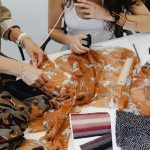When you tackle your next crafting project, consider how the right pins can make a significant difference. You might not realize it, but choosing the appropriate type and size of pins based on fabric thickness is just the beginning. Proper placement can keep your seams straight, while an organized pin system ensures you won't waste time searching for them. If you think you've been pinning correctly, it may be time to reassess. There are some common pitfalls that could be affecting your results, and understanding them could transform your crafting experience entirely.
Table of Contents
Key Takeaways
- Choose the right pins based on fabric type; fine pins for lightweight fabrics and sturdier pins for thicker materials like denim.
- Position pins perpendicular to fabric edges to ensure straight stitching and easy removal while sewing.
- Organize pins by type and size in designated containers for easy access and efficient workflow during crafting.
- Use pins to align fabric accurately along seam lines, ensuring precise placement and a professional finish in your projects.
Choosing the Right Pins
When selecting pins for your project, consider the fabric type and the purpose to ensure you're using the best option for your needs. Different fabrics require different pins. For lightweight fabrics like silk or chiffon, opt for fine, sharp pins that won't leave noticeable holes. Conversely, for thicker materials like denim or canvas, choose sturdier pins that can penetrate layers without bending.
Think about the purpose of your project as well. If you're quilting, you might prefer long quilting pins that hold multiple layers securely. For delicate seams, glass-headed pins can easily be removed without snagging the fabric.
Magnetic or plastic pin cushions can help keep your pins organized while you work, making it easier to grab the right one when you need it.
Lastly, always check the length of the pins. Longer pins can be helpful for bulkier projects, while shorter pins are ideal for finer work. By choosing the right pins, you not only enhance the precision of your work but also make the crafting process smoother and more enjoyable. Investing time in selecting the right pins saves you frustration later on.
Pin Placement Techniques
Proper pin placement can significantly impact the accuracy and quality of your sewing projects. Start by positioning your pins perpendicular to the fabric edges, ensuring they don't interfere with your sewing line. This helps you maintain a straight stitch and reduces the chances of shifting fabric layers during sewing.
When working with curves or angles, place your pins closer together. This provides better stability and allows for smoother transitions, preventing puckering in your finished product. For thicker fabrics, use longer pins to penetrate multiple layers effectively.
It's also smart to pin in a way that allows you to remove them easily while sewing. Pin in the same direction as your sewing path, which lets you pull them out as you reach each one.
Don't forget to avoid pinning too close to the seam allowance, as this can create bulky areas that are hard to sew over.
Organizing Your Pins
To keep your sewing area efficient and free of clutter, organizing your pins is essential for quick access and ease of use. Start by choosing a designated container, like a pin cushion or a small jar, to store your pins. This way, you'll always know where to find them. Consider using a magnetic pin holder; it makes picking up stray pins a breeze.
Next, sort your pins by type. For example, group together your straight pins, safety pins, and specialty pins. Label each section if your container allows it; this will save you time when you need a specific pin.
If you've got various lengths or thicknesses, keep those organized too. You can use small boxes or even repurpose an old ice cube tray to separate them.
Regularly check your pins for any that are bent or damaged, and dispose of them. A clean, well-organized pin collection not only makes your crafting more enjoyable but also enhances your efficiency. With everything in its place, you'll spend less time searching and more time creating!
Using Pins for Precision
Organized pins not only save time but also help you achieve precision in your sewing projects. When you use pins effectively, you can ensure that your fabric aligns perfectly, which is crucial for a professional finish.
Here are some tips to help you pin with precision:
- Use the right type of pin: Different fabrics require different pins. For example, use fine pins for delicate fabrics and thicker pins for heavier materials. This prevents distortion and keeps everything in place.
- Pin along seam lines: Instead of randomly pinning, place your pins along the seam line. This method helps you align fabric edges accurately and makes sewing easier.
- Space your pins evenly: Avoid clumping your pins too closely together. Spacing them evenly allows for better control as you sew, making it easier to manage curves and corners.
- Remove pins as you sew: Pull out pins just before they reach your presser foot. This practice keeps your fabric from shifting and helps you maintain a straight line, resulting in a more precise finish.
Avoiding Common Pinning Mistakes
When you're pinning, it's crucial to choose the right pin size for your materials.
You also need to secure your pins properly to avoid any slips during your project.
Plus, organizing your pin placement can save you time and frustration, ensuring a smoother crafting experience.
Choose Appropriate Pin Size
Choosing the right pin size can make a significant difference in your crafting projects, as using pins that are too long or too short often leads to frustration and uneven results. To ensure you select the appropriate pin size, consider these essential tips:
- Fabric Thickness: Match your pin size to the thickness of the fabric. For lightweight fabrics, opt for shorter pins, while thicker materials require longer pins to secure layers effectively.
- Project Type: Think about the nature of your project. Quilting may demand longer, sturdier pins, while delicate embroidery can work well with finer, shorter pins.
- Pin Head Size: Choose pin heads that are easy to grasp and won't get lost in your fabric. Larger heads can be helpful for visibility and ease of handling.
- Avoiding Damage: Remember that using pins that are too long can snag or damage your fabric. Always aim for a pin size that minimizes the risk of tearing while still providing adequate hold.
Secure Pins Properly
Secure your pins properly to prevent slipping and ensure your fabric layers stay aligned during the crafting process. Misplaced pins can lead to uneven seams or misaligned patterns, so it's essential to pin effectively. Here are some common pinning mistakes and how to avoid them:
| Mistake | Solution |
|---|---|
| Inserting pins too far apart | Pin closer together for stability |
| Using dull pins | Choose sharp pins for better grip |
| Pinning perpendicular to the seam | Pin parallel to the seam for easier removal |
| Overcrowding with too many pins | Use only as many as needed to secure |
| Forgetting to remove pins while sewing | Set reminders to avoid needle damage |
Organize Pin Placement Efficiently
Efficient pin placement is crucial for achieving precise and professional-looking results in your crafting projects. When you organize your pin placement thoughtfully, you can avoid common pinning mistakes that may lead to frustration or errors. Here are some tips to help you pin more effectively:
- Plan Your Layout: Before you start pinning, visualize where each pin should go. This helps in maintaining even spacing and ensures your fabric pieces align correctly.
- Use the Right Pin Type: Different projects require different pins. For instance, use quilting pins for thick layers and fine pins for delicate fabrics to avoid damaging them.
- Pin Parallel to the Edge: Always pin parallel to the edge of your fabric. This makes it easier to remove the pins as you sew and reduces the chances of accidentally sewing over a pin.
- Avoid Over-Pinning: While it's important to secure your fabric, over-pinning can create unnecessary bulk. Aim for a balance that keeps everything in place without complicating your sewing process.
Creative Pinning Ideas
Get ready to explore inventive ways to use pins that can elevate your crafting projects to a whole new level. Pins aren't just for holding fabric in place; they can be your secret weapon for creativity.
For instance, try using colorful pins to create a stunning visual effect on your bulletin board or inspiration wall. Arrange them in patterns or shapes, and watch as your workspace transforms into an art piece.
Another idea is to use pins as markers in your projects. If you're quilting, place pins at intersections to guide your sewing, ensuring precision without constant measuring. You can also use pins to attach embellishments like lace or beads, adding intricate details that catch the eye.
Don't forget about pinning fabric swatches together before cutting. This helps you visualize your final product and prevents fabric waste.
Frequently Asked Questions
What Types of Materials Are Best Suited for Pinning?
When pinning, you've got to consider materials like fabric, felt, or corkboard. These hold pins well and prevent slipping. Avoid overly thick or hard materials, as they can make pinning difficult and less effective.
Are There Eco-Friendly Options for Pins Available?
Yes, there're eco-friendly pin options available! You can find pins made from recycled materials or biodegradable substances. These alternatives reduce environmental impact while still providing the functionality you need for your projects.
Can I Reuse Pins After They've Been Used?
Yes, you can definitely reuse pins after they've been used. Just make sure to clean them thoroughly to remove any residue, and check for any damage. Reusing pins is not only practical but also eco-friendly!
How Do I Clean Pins After Use?
To clean your pins after use, soak them in warm, soapy water for a few minutes. Then, scrub gently with a cloth or sponge, rinse thoroughly, and let them dry completely before storing.
Where Can I Purchase Specialty Pins for Unique Projects?
You can purchase specialty pins at local craft stores, online retailers like Amazon, or dedicated sewing supply shops. Don't forget to check specialty websites focused on sewing and crafting for unique options tailored to your projects.
- How Does Ring Spun Cotton Affect Garment Fit and Shape Retention? - August 13, 2024
- What Are the Challenges in Producing Ring Spun Cotton? - August 13, 2024
- Is Ring Spun Cotton Suitable for Plus-Size Clothing? - August 13, 2024







